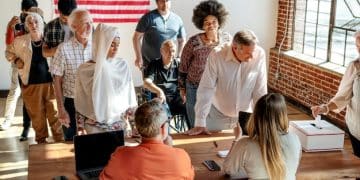US Immigration Policy 2025: What it Means for Skilled Workers

The revised US immigration policy for 2025 aims to streamline processes and address labor market needs, primarily impacting skilled workers through changes in visa categories, application procedures, and potentially increasing opportunities in critical sectors.
As 2025 approaches, many skilled professionals and companies alike are asking: What Does the Revised US Immigration Policy Mean for Skilled Workers in 2025? Understanding these potential shifts is crucial for strategic planning, career development, and business continuity in an increasingly interconnected global economy. This article will delve into the anticipated changes, their implications, and how skilled workers can best prepare.
Anticipated Shifts in US Immigration Priorities for 2025
The landscape of US immigration policy is often dynamic, responding to economic needs, geopolitical changes, and domestic considerations. For 2025, discussions within policy circles suggest a renewed focus on attracting and retaining high-skilled talent, particularly in sectors deemed critical for national competitiveness and innovation.
Such shifts are not unprecedented. Historically, US immigration has adapted to various demands, from agricultural labor in earlier centuries to highly specialized tech workers today. The Biden administration, for instance, has signaled an intent to reform aspects of the immigration system, though concrete legislative changes can face significant hurdles. The emphasis often lies on balancing economic imperatives with national security and humanitarian concerns.
Key Drivers of Policy Revisions
Several factors typically drive revisions in US immigration policy, especially concerning skilled workers. These include:
- Economic Competitiveness: Ensuring the US remains a global leader in technology, research, and development often necessitates importing specialized skills that are scarce domestically.
- Labor Market Gaps: Specific industries, such as healthcare, STEM (Science, Technology, Engineering, and Mathematics), and advanced manufacturing, frequently report shortages of qualified personnel.
- Global Talent Race: Other developed nations are actively competing for the world’s top talent, pressuring the US to refine its policies to remain attractive.
- Technological Advancements: The rapid evolution of fields like AI, biotechnology, and cybersecurity creates demand for new skill sets that the domestic education system may not yet be producing at scale.
The proposed policy changes for 2025 are likely to reflect a strategic attempt to address these interconnected challenges, seeking to create a more agile and responsive immigration framework for skilled labor.
These policy shifts represent more than just bureaucratic adjustments; they are a direct response to the evolving needs of the US economy and its position in the global arena. The aim is to ensure a continuous influx of talent that can drive innovation, create jobs, and maintain the nation’s competitive edge.
The anticipated revisions underscore a pragmatic approach to immigration, where the emphasis is on leveraging global talent to strengthen key domestic industries and foster economic growth. While the exact contours of the 2025 policy remain subject to legislative processes and political will, the underlying drivers suggest a clear direction towards a more skills-based immigration system.
Understanding Potential Changes to Visa Categories
For skilled workers, the most direct impact of revised immigration policies often manifests in changes to existing visa categories or the introduction of new ones. The H-1B visa, the primary non-immigrant visa for skilled workers, is frequently at the center of such discussions due to its high demand and annual cap.
Any revisions to the H-1B program could significantly alter access for foreign professionals. This might involve adjustments to the lottery system, changes to minimum wage requirements for sponsored workers, or even a re-evaluation of the cap itself. Beyond H-1B, other pathways like the L-1 visa (for intra-company transfers) and O-1 visa (for individuals with extraordinary ability) could also see modifications aimed at improving efficiency or targeting specific types of talent.
H-1B Visa Adjustments and Their Implications
The H-1B program, while critical for many US companies, has been a subject of intense debate. Criticisms often revolve around its lottery system, which prioritizes randomness over merit, and concerns about its potential impact on domestic wages. In response, 2025 policies might introduce a new allocation system, possibly prioritizing higher-wage jobs or those in critical technology sectors. This could mean a more predictable pathway for certain highly specialized professionals.
- Wage-Based Allocation: A shift towards prioritizing H-1B petitions for jobs offering higher salaries, potentially reducing competition for entry-level positions.
- STEM Specialization: Increased preference or specific allocations for graduates in STEM fields, particularly those with advanced degrees.
- Streamlined Processing: Efforts to reduce backlogs and accelerate adjudication times for H-1B petitions, benefiting both employers and applicants.
These adjustments could make the H-1B a more targeted tool for addressing specific talent gaps, rather than a broad mechanism. For skilled workers, this means a need to align their qualifications and desired roles more closely with stated US economic priorities.

Potential Changes to Employment-Based Green Cards (EB Categories)
While non-immigrant visas like H-1B allow temporary stay, many skilled workers aspire to permanent residency through Employment-Based (EB) green cards. The current system is hampered by per-country caps, leading to decades-long waits for applicants from countries like India and China.
For 2025, there’s growing bipartisan support for reforms that would address these backlogs. This could involve eliminating or raising per-country caps, recapturing unused green card numbers, or re-categorizing certain types of skilled workers to accelerate their path to permanent residency. Such changes would be transformative, offering greater stability and predictability for many long-term residents and new arrivals alike.
The focus on employment-based green cards is not merely about increasing numbers but about creating a more equitable and efficient system. Reducing backlogs would allow more skilled individuals to fully contribute to the US economy without the constant worry of visa expiry or an uncertain future. These reforms also aim to retain vital talent already in the US, preventing them from leaving due to prolonged waits.
Ultimately, any changes to visa categories, whether temporary or permanent, will aim to finely tune the US immigration system to meet the demands of a 21st-century economy. Skilled workers will need to stay informed and potentially adapt their strategies based on these evolving frameworks.
Impact on Key Industries and Labor Markets
The revised US immigration policy for 2025 is expected to have a significant ripple effect across various industries, particularly those heavily reliant on specialized skills. Sectors like technology, healthcare, advanced manufacturing, and scientific research are perpetual consumers of skilled international talent. Any policy adjustment can either facilitate growth or introduce new challenges for these vital economic engines.
For instance, an immigration policy that prioritizes STEM professionals could further fuel innovation hubs in Silicon Valley, Boston, and other tech centers. Conversely, restrictions or increased bureaucratic hurdles could lead to a ‘brain drain,’ where top talent seeks opportunities in more accessible nations.
Technology Sector: Continued Demand, Potential Streamlining
The technology sector remains at the forefront of global competition, and its reliance on skilled foreign workers is well-documented. From software developers and data scientists to AI specialists and cybersecurity experts, the demand often outstrips domestic supply. For 2025, policies might introduce specific provisions or faster processing for tech professionals, recognizing their critical role in maintaining US competitiveness.
- AI and ML Specialists: Dedicated pathways for experts in artificial intelligence and machine learning, given their strategic importance.
- Cybersecurity Professionals: Fast-tracked visas for those protecting critical infrastructure and data.
- Venture Capital Access: Policies that facilitate entrepreneurial immigrants in tech, potentially through start-up visas or expedited green card processes for founders.
These targeted approaches would not only help fill critical vacancies but also encourage innovation and the creation of new businesses within the US. The policy aims to strengthen the ecosystem that has made the US a leader in technological advancement.
However, the tech industry also faces challenges, such as the debate over outsourcing and the impact of automation on certain roles. Future policies will likely seek to strike a balance, ensuring that foreign talent complements domestic labor without displacing it. This nuanced approach is essential for long-term economic stability and growth.
Healthcare and Medical Field: Addressing Critical Shortages
The healthcare sector in the US faces persistent shortages, particularly in rural areas and specialized fields. Nurses, doctors (especially specialists), and allied health professionals are consistently in high demand. The 2025 immigration policy could introduce measures to ease the entry of foreign-trained medical professionals, recognizing the pressing public health needs.
This might involve streamlined credential recognition processes, increased visa allocations for healthcare workers, or even specific programs to incentivize relocation to underserved areas. Such measures would directly alleviate strain on the healthcare system, improving access to care across the nation. The ongoing debates surrounding physician and nurse shortages highlight the necessity for a robust immigration pipeline in these areas.
Moreover, the pandemic underscored the vital role of medical researchers and scientists, many of whom are foreign-born. Any policy revision for 2025 is likely to continue supporting the entry of top scientific talent to maintain leadership in biomedical research and public health. This strategic view ensures that the US remains at the forefront of medical innovation and response to future health crises.
The impact of revised immigration policies extends beyond talent acquisition; it also influences wage dynamics, innovation cycles, and the overall competitiveness of the US economy. Skilled workers need to understand these sectoral implications to position themselves effectively in the evolving labor market.
Navigating the Application Process: Expected Changes and Challenges
Beyond policy shifts, the practicalities of applying for US visas and green cards can present significant hurdles. For skilled workers in 2025, understanding any changes to the application processes will be as important as knowing the new policies themselves. These could range from adjustments in required documentation to the adoption of new digital platforms for submissions.
Given the push for modernization within government agencies, there’s a possibility of more digitized and streamlined application portals. However, such changes can also introduce new challenges, like technical glitches or the need for applicants to adapt to unfamiliar systems. Keeping abreast of official guidance from agencies like USCIS (US Citizenship and Immigration Services) and the Department of State will be paramount.
Emphasis on Digitalization and Efficiency
A recurring theme in administrative reform is the pursuit of greater efficiency through digitalization. For immigration, this could translate into:
- Online Application Platforms: Expanding the range of visa categories that can be fully applied for and managed through online portals, reducing paper-based submissions.
- Automated Pre-screening: Use of artificial intelligence or machine learning for initial screening of applications, potentially speeding up initial review times.
- Consolidated Information Hubs: Centralized online resources for applicants to track their status, submit additional documents, and receive updates, simplifying communication.
While these advancements promise to reduce processing times and enhance user experience, they also require robust cybersecurity measures and clear instructions to prevent errors. Skilled workers will need to be particularly meticulous when navigating these digital systems.
The transition to more digital processes is not without its difficulties. Initial rollout phases might encounter technical issues, and applicants without reliable internet access or digital literacy could face disadvantages. Therefore, it’s crucial for the government to provide clear guidelines and support during this transition, ensuring equitable access for all eligible skilled workers.
Increased Scrutiny and Enhanced Background Checks
Alongside efficiency, national security remains a top priority. Skilled workers applying for US visas in 2025 might encounter:
- More Detailed Background Checks: Enhanced scrutiny of educational qualifications, employment history, and digital footprints.
- Personal Interviews: A continued or increased emphasis on in-person interviews at consulates and embassies, allowing for direct assessment of an applicant’s intent and qualifications.
- Data Sharing: Greater collaboration and data sharing between various US government agencies to cross-reference information and detect inconsistencies.
These measures aim to ensure the integrity of the immigration system and prevent fraud. For applicants, this means ensuring all submitted information is accurate, consistent, and verifiable. Any discrepancies could lead to delays or even outright denials. Preparing thoroughly for interviews and maintaining precise records will be more important than ever.
The increased scrutiny also underscores the need for clear communication and transparency from the government. Applicants should be fully aware of what information is being collected, how it is being used, and what recourse they have in case of errors or misunderstandings. Trust in the system is built on fairness and predictability.
Navigating these application changes will require diligence, adaptability, and access to reliable information. Skilled workers are encouraged to consult official government websites and, if necessary, seek advice from experienced immigration legal professionals.
Legal and Ethical Considerations in Revised Policies
Any comprehensive revision of US immigration policy, especially one impacting skilled workers, necessitates a thorough examination of its legal and ethical underpinnings. The intricate balance between national interests, economic needs, and individual rights is constantly at play. For 2025, discussions might revolve not just around who gets in, but how they are treated under the law and what protections are afforded to them.
Key legal frameworks, such as the Immigration and Nationality Act (INA), would serve as the foundation for any new regulations or legislative changes. Ethical considerations often surface in debates about fairness, equity, and the broader societal impact of immigration. These discussions are crucial for developing policies that are both effective and just.
Ensuring Fairness and Preventing Discrimination
A primary ethical concern in immigration policy is the prevention of discrimination. Any revised policy for 2025 needs to rigorously uphold principles of fairness, ensuring that:
- Merit-Based Criteria: If merit-based systems are introduced, they must be transparent and genuinely tied to economic needs, avoiding subjective biases.
- Equal Treatment: Policies must apply equally to all eligible applicants, regardless of nationality, race, gender, or religion, provided they meet the criteria.
- Due Process: Applicants must be afforded clear avenues for appeal and review in cases of denial or dispute, upholding fundamental legal rights.
The US has a long history of grappling with these issues, and safeguards are typically built into the legal system to address concerns of unfair treatment. Advocacy groups and legal organizations play a crucial role in monitoring these aspects of policy implementation.
Moreover, the ethical imperative extends to protecting vulnerable workers and ensuring they are not exploited. Policies supporting skilled migration should also include provisions for labor protections, addressing issues like unfair wages, poor working conditions, and employer abuses. This holistic approach ensures that attracting talent aligns with upholding human dignity.
Impact on International Human Rights and Collaboration
US immigration policy, by its very nature, has international implications. Decisions made domestically can affect global talent flows, international collaborations in science and research, and even diplomatic relations. As such, any revised policy for 2025 should ideally consider its broader impact on:
- Brain Drain in Origin Countries: While attracting talent, the US should be mindful of the potential negative consequences for developing nations losing their highly educated professionals.
- Scientific Collaboration: Policies that restrict academic exchange or research partnerships could impede global progress in critical fields like climate change or disease research.
- Geopolitical Influence: A restrictive or punitive immigration policy could diminish the US’s standing as a welcoming hub for global talent, impacting its soft power.
Engagement with international organizations and adherence to human rights principles can help ensure that US immigration policies are not only effective domestically but also contribute positively to global development and stability. The balance between national self-interest and global responsibility is delicate but essential for sustainable policy.

Legal and ethical considerations serve as critical guardrails in the policy-making process. They ensure that revised immigration rules for skilled workers are not just economically beneficial but also align with broader principles of justice, fairness, and international cooperation. Engaging with these aspects creates a more robust and resilient immigration system.
Recommendations for Skilled Workers and Employers
Given the anticipated changes in US immigration policy for 2025, proactive planning is essential for both skilled workers seeking opportunities and employers looking to attract and retain global talent. Adapting to new regulations requires foresight, meticulous preparation, and often, professional guidance.
For skilled workers, this means a rigorous self-assessment of their qualifications, understanding market demands, and potentially upskilling to meet evolving industry needs. For employers, it entails re-evaluating recruitment strategies, ensuring compliance with new rules, and fostering an environment that supports international talent.
Strategies for Skilled Workers
To navigate the evolving landscape, skilled workers should consider the following:
- Target In-Demand Skills: Research and acquire skills that are consistently in high demand in the US labor market, particularly within critical sectors like tech and healthcare. Focus on areas with reported shortages.
- Strengthen Credentials: Ensure academic and professional qualifications are comprehensive and easily verifiable. Consider getting foreign credentials evaluated by US-recognized agencies beforehand.
- Network Actively: Building professional connections within US industries can lead to sponsorship opportunities and valuable insights into market needs and employer preferences.
- Seek Legal Counsel: Engage with qualified immigration attorneys early in the process. Their expertise can be invaluable in understanding complex regulations, preparing documents, and navigating applications.
Additionally, staying informed directly from official government sources like the USCIS website is crucial to avoid misinformation. Participation in professional associations related to one’s field can also provide up-to-date information on industry-specific immigration trends.
Advice for US Employers
US employers looking to sponsor skilled foreign workers should adopt a strategic approach:
Stay updated on new regulations and compliance requirements. Immigration laws are dynamic, and ignorance is no defense against non-compliance. Assign a dedicated team or individual to monitor policy changes and their operational implications.
Review and potentially adjust internal recruitment strategies. Consider sourcing talent from diverse global pools if certain skill sets are difficult to find domestically. This includes strengthening relationships with international universities and professional organizations.
Ensure robust internal processes for visa sponsorship. This includes meticulous record-keeping, adherence to prevailing wage requirements, and transparent communication with sponsored employees regarding their visa status and rights. The Department of Labor and USCIS conduct routine audits, and compliance is paramount.
Engage with professional immigration legal services. Law firms specializing in corporate immigration can provide invaluable advice on navigating complex visa applications, managing compliance risks, and developing long-term talent acquisition strategies that align with US immigration laws.
Advocate for sensible immigration reform. Employers can collectively voice their needs to policymakers, emphasizing the economic benefits of skilled immigration and advocating for policies that foster predictability and efficiency in the system.
By implementing these recommendations, both skilled workers and employers can better position themselves to thrive amidst the anticipated changes in US immigration policy for 2025.
Future Outlook and Long-Term Implications for Skilled Migration
Looking beyond 2025, the trajectory of US immigration policy for skilled workers will likely be shaped by a confluence of factors, including global economic shifts, technological advancements, and domestic political landscapes. The long-term implications for skilled migration to the US extend beyond immediate visa changes, touching upon the nation’s global competitiveness, innovation capacity, and demographic future.
One notable trend is the increasing global competition for talent. As other countries, particularly in Europe and Asia, ease their immigration policies to attract skilled professionals, the US may face pressure to maintain its appeal. This competition could force more significant, fundamental reforms to its immigration system in the years to come.
The Role of Economic and Technological Trends
The pace of technological change is a critical determinant. As emerging fields like quantum computing, advanced robotics, and bio-engineering mature, the specific skill sets required will evolve. Immigration policy must be agile enough to respond to these needs, rather than lagging behind. This might mean:
- Dynamic Visa Categories: The creation of more flexible visa types that can be quickly adapted to new and emerging skill requirements.
- Pathways for Innovators: More robust programs for entrepreneurs and founders who wish to launch high-growth companies in the US.
- Skills-Based Points Systems: Potential movement towards a more comprehensive skills-based immigration system, similar to those in Canada or Australia, which award points for various attributes.
These trends suggest a future where immigration policy is less about broad categories and more about precise targeting of human capital essential for economic leadership. The focus will be on attracting individuals who can contribute to bleeding-edge innovation.
Furthermore, global supply chain resilience and national security concerns may also influence migration policy. Countries may seek to onshore critical manufacturing and research, requiring an influx of specialized engineers and scientists. This strategic imperative could elevate certain skill sets in the hierarchy of immigration priorities.
Adapting to a Globalized Talent Market
The global talent market is becoming increasingly fluid. Skilled professionals now have more options than ever before, and they are willing to relocate to countries that offer not just job opportunities but also a welcoming environment, clear pathways to permanent residency, and a good quality of life. For the US, this means that its immigration policies must be competitive on a global scale.
Long-term implications could include a shift from a purely demand-driven system to one that actively recruits and retains top global talent. This would involve proactive engagement with international universities, participation in global recruitment fairs, and clearer communication about the benefits of a career in the US.
The role of international students in US universities is also a crucial long-term consideration. Many of these students, especially at the graduate level, come to the US for STEM education and often wish to stay and work. Policies that provide clearer and more stable pathways for these graduates to transition into the workforce would be vital for maintaining a strong talent pipeline.
Ultimately, the long-term outlook suggests that US immigration policy for skilled workers will continue to evolve, driven by a complex interplay of economic, technological, and geopolitical forces. Adaptability, strategic planning, and a commitment to competitive and fair policies will be crucial for the US to remain a magnet for global talent.
| Key Point | Brief Description |
|---|---|
| 📊 Policy Focus | Anticipated shift towards skills-based immigration, targeting critical sectors like tech and healthcare to boost US competitiveness. |
| 📜 Visa Changes | Potential H-1B reforms (e.g., wage-based allocation) and efforts to reduce employment-based green card backlogs. |
| 💻 Industry Impact | Significant effects expected in tech and healthcare, with potential for streamlined access for specific, in-demand professionals. |
| 📝 Application Process | Increased digitalization and scrutiny anticipated, requiring meticulous documentation and preparation from applicants. |
Frequently Asked Questions About US Immigration Policy 2025
While definitive changes are yet to be finalized, discussions suggest potential alterations to the H-1B lottery system for 2025. These could include prioritizing higher-wage jobs or those in critical STEM fields. The aim is often to make the visa allocation more strategically aligned with US economic needs. Applicants should monitor official USCIS announcements closely for specific details as they emerge.
There is growing bipartisan support for addressing per-country caps that currently cause significant backlogs for employment-based green cards from certain high-demand countries. While legislative changes are complex, 2025 could see reforms aimed at eliminating or raising these caps, or recapturing unused visa numbers. This would benefit many skilled workers facing long waits for permanent residency in the US.
Industries experiencing significant skill shortages and those deemed critical for US economic competitiveness are most likely to benefit. These typically include technology (especially AI, cybersecurity, and data science), healthcare (doctors, nurses, specialists), and advanced manufacturing. Policies may offer streamlined processes or increased visa allocations for professionals in these high-demand sectors, addressing labor market gaps effectively.
Skilled workers should focus on acquiring in-demand skills, ensuring their credentials are robust and verifiable, and networking within their target industries. Staying informed through official government sources (like USCIS), consulting with immigration attorneys for personalized advice, and meticulously preparing all necessary documentation are also crucial steps. Proactive preparation can significantly enhance a worker’s chances.
Yes, there’s an ongoing push for greater digitalization and efficiency within US immigration agencies. Applicants might increasingly find themselves using online platforms for submissions and tracking. Simultaneously, expect continued or increased scrutiny through enhanced background checks and potentially more in-person interviews. This dual focus on efficiency and security means applicants need to be meticulous and precise in their submissions.
Conclusion
The anticipated revisions to US immigration policy for 2025 reflect a strategic effort to align the nation’s immigration framework with its evolving economic needs and global standing. For skilled workers, these changes present both opportunities and challenges, underscoring the imperative for informed preparation and adaptability. By understanding the potential shifts in visa categories, the implications for key industries, and the nuances of the application process, skilled professionals can better position themselves to contribute to and benefit from the dynamic US labor market. Ultimately, a flexible and responsive immigration system is vital for the US to maintain its competitive edge and continue attracting the world’s most valuable talent.





